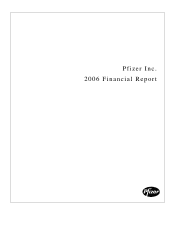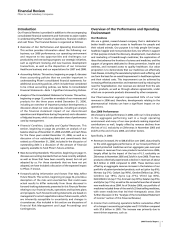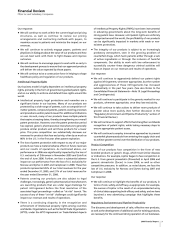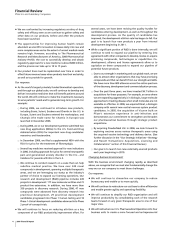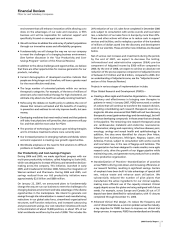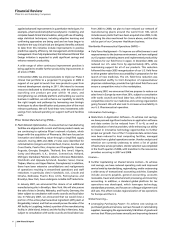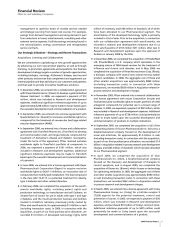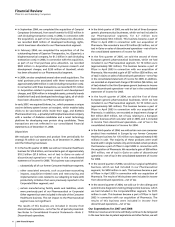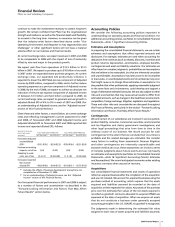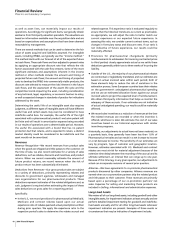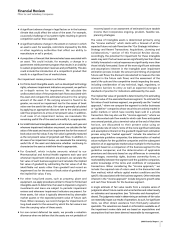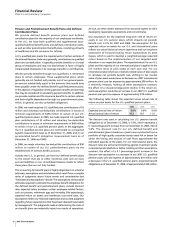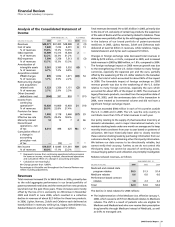Pfizer 2006 Annual Report Download - page 5
Download and view the complete annual report
Please find page 5 of the 2006 Pfizer annual report below. You can navigate through the pages in the report by either clicking on the pages listed below, or by using the keyword search tool below to find specific information within the annual report.
Our response:
•
We will continue to work within the current legal and pricing
structures, as well as continue to review our pricing
arrangements and contracting methods with payers, to
maximize access to patients and minimize the impact on our
revenues.
•
We will continue to actively engage payers, patients and
physicians in dialogues about the value of our products and how
we can best work with them to fight disease and improve
outcomes.
•
We will continue to encourage payers to work with us early in
the development process to ensure that our approved products
will deliver the value expected by those payers.
•
We will continue to be a constructive force in helping to shape
healthcare policy and regulation of our products.
Intellectual Property Rights
Our business model is highly dependent on intellectual property
rights, primarily in the form of government-granted patent rights,
and on our ability to enforce and defend those rights around the
world.
•
Intellectual property legal protections and remedies are a
significant factor in our business. Many of our products are
protected by a wide range of patents, such as composition-of-
matter patents, compound patents, patents covering processes
and procedures and/or patents issued for additional indications
or uses. As such, many of our products have multiple patents
that expire at varying dates, thereby strengthening our overall
patent protection. However, once the patent protection period
has expired, generic pharmaceutical manufacturers generally
produce similar products and sell those products for a lower
price. This price competition can substantially decrease our
revenues for products that lose exclusivity, often by as much as
80% in the U.S. in the first year after patent expiration.
•
The loss of patent protection with respect to any of our major
products can have a material adverse effect on future revenues
and our results of operations. As mentioned above, our
performance in 2006 was significantly impacted by the loss of
U.S. exclusivity of Zithromax in November 2005 and Zoloft at
the end of June 2006. Further, we face a substantial adverse
impact on our performance from the loss of U.S. exclusivity for
Norvasc and Zyrtec in 2007 and Camptosar in 2008. These five
products represented 26% of our total revenues for the year
ended December 31, 2005, and 21% of our total revenues for
the year ended December 31, 2006.
•
Patents covering our products are also subject to legal
challenges. Increasingly, generic pharmaceutical manufacturers
are launching products that are under legal challenge for
patent infringement before the final resolution of the
associated legal proceedings—called an “at-risk” launch. The
success of any of these “at-risk” challenges could significantly
impact our revenues and results of operations.
•
There is a continuing disparity in the recognition and
enforcement of intellectual property rights among countries
worldwide. Organizations such as the World Trade Organization
(WTO), under the WTO Agreement on Trade-Related Aspects
of Intellectual Property Rights (TRIPS), have been instrumental
in educating governments about the long-term benefits of
strong patent laws. However, until patent rights are uniformly
recognized around the world, the profitability of our products
can be significantly impacted in markets with weak or non-
existent protections.
•
The integrity of our products is subject to an increasingly
predatory atmosphere, seen in the growing problem of
counterfeit drugs, which harm patients either through a lack
of active ingredients or through the inclusion of harmful
components. Our ability to work with law enforcement to
successfully counter these dangerous criminal activities will
have an impact on our revenues and results of operations.
Our response:
•
We will continue to aggressively defend our patent rights
against infringement, whenever appropriate, but the number
and aggressiveness of these infringements has increased
substantially in the past few years. (See also Notes to the
Consolidated Financial Statements—Note 19. Legal Proceedings
and Contingencies).
•
We will continue to participate in the generics market for our
products, whenever appropriate, once they lose exclusivity.
•
We will continue to take actions to deliver more products of
greater value more quickly. (See further discussion in the
“Regulatory Environment and Pipeline Productivity” section of
this Financial Review.)
•
We will continue to support efforts that strengthen worldwide
recognition of patent rights, while taking necessary steps to
ensure appropriate patient access.
•
We will continue to employ innovative approaches to prevent
counterfeit pharmaceuticals from entering the supply chain and
to achieve greater control over the distribution of our products.
Product Competition
Some of our products face competition in the form of new
branded products or generic drugs, which treat similar diseases
or indications. For example, Lipitor began to face competition in
the U.S. from generic pravastatin (Pravachol) in April 2006 and
generic simvastatin (Zocor) in June 2006, as well as other
competitive pressures. In addition, as noted above, we face the
loss of U.S. exclusivity for Norvasc and Zyrtec during 2007 and
Camptosar in 2008.
Our response:
•
We will continue to highlight the benefits of our products, in
terms of cost, safety and efficacy, as appropriate. For example,
the success of Lipitor is the result of an unprecedented array
of clinical data supporting both efficacy and safety, and we have
launched a new advertising campaign that highlights these
benefits.
Regulatory Environment and Pipeline Productivity
The discovery and development of safe, effective new products,
as well as the development of additional uses for existing products,
are necessary for the continued strong operation of our businesses.
2006 Financial Report 3
Financial Review
Pfizer Inc and Subsidiary Companies

